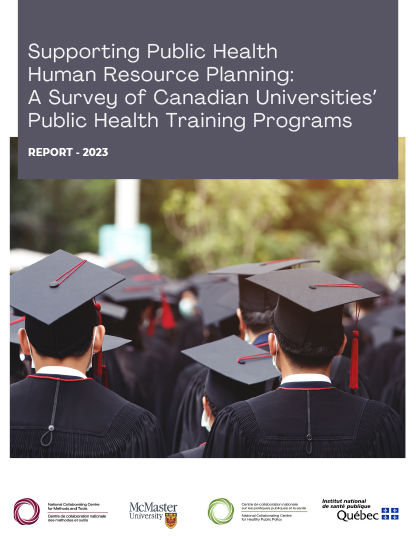Supporting Public Health Human Resource Planning: A Survey of Canadian Universities’ Public Health Training Programs
The full document and its summary are intended to inform individuals and organizations involved in discussions about the training capacities of public health programs in Canadian universities, and about Canada's public health workforce planning in the context of public health system transformation and the post-COVID-19 era.
This report was developed by the National Collaborating Centre for Healthy Public Policy (NCCHPP) and the National Collaborating Centre for Methods and Tools (NCCMT), in collaboration with the Network of Schools and Programs of Population and Public Health (NSPPPH), in response to a request from the Public Health Agency of Canada (PHAC).
Short overview of pan-Canadian initiatives related to public health training capacity since the early 2000s
According to information gathered, in the aftermath of the Severe Acute Respiratory Syndrome (SARS) outbreak in 2003, the National Advisory Committee on SARS and Public Health (Naylor Committee) reported that a thorough review of public health training programs was needed and that new entrants to the public health workforce would have to be appropriately qualified (Naylor & National Advisory Committee on SARS and Public Health, 2003). Following recommendations from this committee, the Pan-Canadian Public Health Network (Public Health Network), a key intergovernmental mechanism for public health collaboration was created (Pan-Canadian Public Health Network, 2008). Through its various activities, the Public Health Network Council (part of the Pan-Canadian Public Health Network) oversaw the implementation of actions recommended in the report Building a Public Health Workforce for the 21st Century – A Pan-Canadian Framework for Public Health Human Resources Planning (Joint Task Group on Public Health Human Resources, 2005), among which were those targeting a better understanding of public health training capacities in Canadian universities.
Highlights of the 2022 data collection on public health programs offered in Canadian universities
Our 2022 data collection provides information on the location of Canadian universities offering public health programs, the types of programs and degrees they lead to, and the number of students enrolled in and graduated from these programs during the period 2017 to 2021. So, the purpose of the 2022 data collection, the detailed results of which are presented in section 4, may be seen as an initial step towards a better understanding of the current public health training capacity in Canadian universities.
Proposed actions to complement the current understanding of Canadian universities’ public health training capacity
In order to complement the information on the supply of public health-related programs offered by Canadian universities, it would be appropriate to:
- Maintain a comprehensive list of all public health academic programs offered by Canadian universities by identifying and classifying titles of all public health-related programs offered (less or more than 30 credits, continuing or professional education training programs) with a particular focus on program titles that include terms such as global health, environmental health, Indigenous health, Aboriginal health, vulnerable population health, health impact, occupational health, but which do not contain or are not directly associated with public health, population or community health, health promotion, epidemiology, etc.
In order to better understand the diversity of undergraduate and graduate programs related to public health offered by Canadian universities, it would be appropriate to:
- Review the curricula, terms and conditions of bachelor’s, master’s, doctoral, medical residencies and other academic training programs related to public health that are offered by Canadian universities.
In order to learn about the employment niches of university students graduating from public health programs, it would be appropriate to:
- Continue routinely collecting data on students enrolled in and graduating from university public health programs in Canada, in order to have information on the programs and a breakdown of students by program;
- Collect data on the employment pathways of graduating students in these programs for a minimum of 5 years after graduation, using compatible methodologies.
In order to maintain a knowledge base on the composition, mix and distribution of Canadian universities’ public health training capacity at the provincial and territorial levels, it would be appropriate to:
- Continue collecting data on students enrolled in and graduating from university public health programs in Canada, according to the provinces or federal territories of the universities offering these programs.
Scope of the project
In this project, we:
- Present an overview of initiatives implemented since the early 2000s which contributed to our understanding of the training capacity of university-based public health programs in Canada;
- Produce relevant, current data on the supply of public health programs offered in Canadian universities in 2022 and on students enrolled in and graduated from these programs in 2017, 2020 and 2021;
- Propose actions for collecting additional data on the supply of university public health programs to better understand public health training capacity in Canada;
- Recognize that information on academic public health training program capacity is only one of the essential components to inform workforce development planning and workforce capacity strengthening;
- Recognize that there is a need to identify the full range of questions and information to comprehensively inform public health workforce development planning and workforce capacity strengthening.


